 So we're now one week out from opening, and I dropped into the laboratory / performance space to have a look at the bump-in. Jack, Mick and designer Gillian Schwab were working away, and everything is coming together in a sort of terrifying order. Looking around at the extraordinary array of equipment, I thought it'd be a good idea to have a chat about how all this stuff works in practice - what are all the different parts of the Word Play machine and how do they fit together?1. Performers are filmedFirst of all, the audience are in one space (the CSIRO Discovery lecture theatre) and the performers are next door to NASA in the Yarralumla Forestry Labs, performing live on camera. The show uses about eight cameras - action-cams mounted on performers, security cameras that operate over a network, more traditional handicams. As well as that there's an array of prerecorded video and information slides.2. Video is mixed and streamed to the internetAll of these video sources are brought into a controller computer in the Yarralumla labs and director Marisa Martin (with the assistance of an operator) decides which camera is sent through to the live feed and when. There are a selection of visual overlays (maps, diagrams and so forth) which are added to the vision at certain points. Throughout the show, Marisa is live video-mixing (literally calling the shots) based on what's been rehearsed, with some room for improvisation.
So we're now one week out from opening, and I dropped into the laboratory / performance space to have a look at the bump-in. Jack, Mick and designer Gillian Schwab were working away, and everything is coming together in a sort of terrifying order. Looking around at the extraordinary array of equipment, I thought it'd be a good idea to have a chat about how all this stuff works in practice - what are all the different parts of the Word Play machine and how do they fit together?1. Performers are filmedFirst of all, the audience are in one space (the CSIRO Discovery lecture theatre) and the performers are next door to NASA in the Yarralumla Forestry Labs, performing live on camera. The show uses about eight cameras - action-cams mounted on performers, security cameras that operate over a network, more traditional handicams. As well as that there's an array of prerecorded video and information slides.2. Video is mixed and streamed to the internetAll of these video sources are brought into a controller computer in the Yarralumla labs and director Marisa Martin (with the assistance of an operator) decides which camera is sent through to the live feed and when. There are a selection of visual overlays (maps, diagrams and so forth) which are added to the vision at certain points. Throughout the show, Marisa is live video-mixing (literally calling the shots) based on what's been rehearsed, with some room for improvisation. 3. Video footage is received and audio overlaidIn the biobox of the Discovery lecture theatre where the audience, Jack and Mick receiving the feed from the Yarralumla space over the internet. (This is a nice touch as it means that the show can technically be linked in to from anywhere in the world.) At this point, Mick is mixing the sound effects and his original score into the feed. Jack is in charge of synching up the instructions for the audience, which appear on a second projector screen in the theatre, as well as appearing on the audience's phone app. These intructions inform the audience how and when to interact with the performance.4. Audience interact via phonesThe audience send SMSes using their phones OR they use the purpose-built app (which you can download upon arrival at the show) to enter different kinds of input: text questions, votes and sometimes a joystick controller.5. Audience input transmitted to DirectorMarisa receives the audience input on a separate controller computer which collates the votes automatically. She can choose from the different submitted questions and select which to pass on to the actors and when.6. Director communicates with performersMarisa calls through the instructions to the actors, who are each fitted with a radio receiver and earpiece.7. Performers respondThe actors have rehearsed a wide variety of scenarios responding to different audience decisions. Sometimes, though, the audience will give them something totally unexpected and they'll be improvising something new.
3. Video footage is received and audio overlaidIn the biobox of the Discovery lecture theatre where the audience, Jack and Mick receiving the feed from the Yarralumla space over the internet. (This is a nice touch as it means that the show can technically be linked in to from anywhere in the world.) At this point, Mick is mixing the sound effects and his original score into the feed. Jack is in charge of synching up the instructions for the audience, which appear on a second projector screen in the theatre, as well as appearing on the audience's phone app. These intructions inform the audience how and when to interact with the performance.4. Audience interact via phonesThe audience send SMSes using their phones OR they use the purpose-built app (which you can download upon arrival at the show) to enter different kinds of input: text questions, votes and sometimes a joystick controller.5. Audience input transmitted to DirectorMarisa receives the audience input on a separate controller computer which collates the votes automatically. She can choose from the different submitted questions and select which to pass on to the actors and when.6. Director communicates with performersMarisa calls through the instructions to the actors, who are each fitted with a radio receiver and earpiece.7. Performers respondThe actors have rehearsed a wide variety of scenarios responding to different audience decisions. Sometimes, though, the audience will give them something totally unexpected and they'll be improvising something new. For anyone who skipped to the end of all that, the short summary is: There's a lot going on in this show. Now come along and check it out.
For anyone who skipped to the end of all that, the short summary is: There's a lot going on in this show. Now come along and check it out.
Word Play
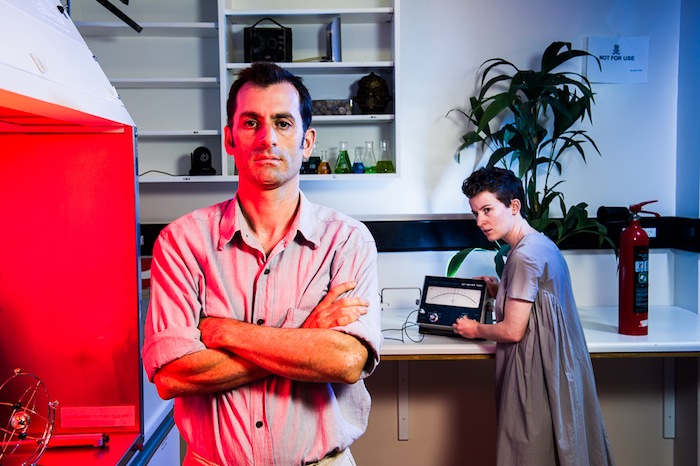 Something is wrong.In the last few months, a new disease has emerged that is transmitted not by water, by air, by contact – but by speech. Language. Via text messaging and email, telephone or video.This disease attacks thought itself, undermining our ability to think critically and resist other people’s influence. This is an epidemic of harmful ideas and broken logic. And it’s spreading. Whole communities of people, highly contagious, wandering about, unable to talk, unable to take care of themselves, looking for things to believe in.Don’t believe everything you hear.---------------------------------------------------------------------------------------------------------------------------------------------------Boho’s new show Word Play is performed on-screen from across the city. The audience are situated in the CSIRO Discovery Centre lecture theatre, while the performers are live-streamed from a laboratory across the city using a high-speed video broadband connection.Using text messages and a purpose-built phone app, the audience are able to interact directly with the performance, communicating with the performers and controlling them through a series of live computer game sequences.Word Play is a performance lecture exploring concepts from epidemiology, a live cinema experience and a hands-on video game in the survival horror genre.Bring your phone.Where: CSIRO Discovery Centre, Clunies Ross street, ActonWhen: 7:30pm Wednesday – Saturday 15-18 May, 22-25 May, 29 May-1 JuneTickets: $20 – buy tickets here.Images by Rohan Thomson.This is a Centenary of Canberra project, proudly supported by the ACT Government & CSIRO.
Something is wrong.In the last few months, a new disease has emerged that is transmitted not by water, by air, by contact – but by speech. Language. Via text messaging and email, telephone or video.This disease attacks thought itself, undermining our ability to think critically and resist other people’s influence. This is an epidemic of harmful ideas and broken logic. And it’s spreading. Whole communities of people, highly contagious, wandering about, unable to talk, unable to take care of themselves, looking for things to believe in.Don’t believe everything you hear.---------------------------------------------------------------------------------------------------------------------------------------------------Boho’s new show Word Play is performed on-screen from across the city. The audience are situated in the CSIRO Discovery Centre lecture theatre, while the performers are live-streamed from a laboratory across the city using a high-speed video broadband connection.Using text messages and a purpose-built phone app, the audience are able to interact directly with the performance, communicating with the performers and controlling them through a series of live computer game sequences.Word Play is a performance lecture exploring concepts from epidemiology, a live cinema experience and a hands-on video game in the survival horror genre.Bring your phone.Where: CSIRO Discovery Centre, Clunies Ross street, ActonWhen: 7:30pm Wednesday – Saturday 15-18 May, 22-25 May, 29 May-1 JuneTickets: $20 – buy tickets here.Images by Rohan Thomson.This is a Centenary of Canberra project, proudly supported by the ACT Government & CSIRO.

Word Play: A whole new kind of interactivity for Boho
Over four full-length shows and a series of shorter works, Boho have experimented with a wide range of interactive mechanisms. Starting back in 2005 with a torchbeam which the audience used as a mouse cursor (Playable Demo) and moving through hacked console controllers (A Prisoner's Dilemma), hands-on models (the sandpile model in Food for the Great Hungers), onstage treasure hunts (True Logic of the Future) through to adapted boardgames (Modelling Play). With Word Play, Boho are trialling a whole new interactive device - the smartphone - while at the same time returning to the company's roots in adapting video game control systems for the stage.I spoke with the duo behind Word Play, Jack Lloyd and Mick Bailey, about the phone-based interactivity within the show. David: Why did you decide to go with smartphone interactivity for this show?Jack: Everyone has a phone. It's an interactive device that's hugely powerful, that everyone knows how to use, and that fit really nicely within the world of the play.Mick: The whole show is operable by SMS, with the intention that the play is accessible to as many people as possible, regardless of the handset they own.Jack: But we have a good relationship with a local iOS developer, Bonobo Labs, who have thrown their support behind developing an app for iPhone and iPad that audience members can use to interact with the show.David: What does the control mechanism look like?Mick: We break the show down into three kinds of interaction - a vote, a message and a control, like arrow keys. This means we can call on the whole audience or just individuals to give their input and guide the show along.
David: Why did you decide to go with smartphone interactivity for this show?Jack: Everyone has a phone. It's an interactive device that's hugely powerful, that everyone knows how to use, and that fit really nicely within the world of the play.Mick: The whole show is operable by SMS, with the intention that the play is accessible to as many people as possible, regardless of the handset they own.Jack: But we have a good relationship with a local iOS developer, Bonobo Labs, who have thrown their support behind developing an app for iPhone and iPad that audience members can use to interact with the show.David: What does the control mechanism look like?Mick: We break the show down into three kinds of interaction - a vote, a message and a control, like arrow keys. This means we can call on the whole audience or just individuals to give their input and guide the show along.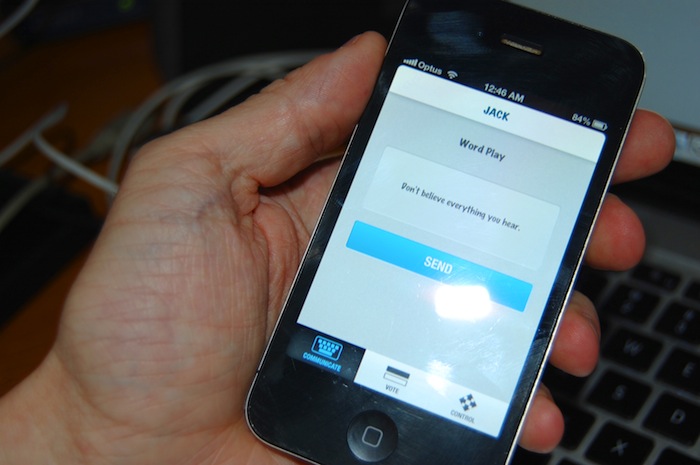 David: What impact does this have on the characters and the show?Jack: We use interactivity to give an audience the opportunity to explore the work from the direction that they're interested in. They can ask us things directly about the world we're presenting, or vote to hear about one thing or another, or even pilot actors around the space. This is hopefully all part of a richer experience for the audience - it adds a liveness and an immediacy to the performance when you know that what the character does next is wholly dependent on your input.David: How do you think this will feel for the audience?Mick: Hopefully it's an intuitive experience for them. It's an unusual format to view a show in, to be sitting in one place and to see it all unfold on the screen, performed in a totally different building, but the interactivity with the audience is crucial - it's really the difference between a live performance and what may as well be prerecorded film. The interactivity makes it theatre again.Jack: I think that when the audience are all huddled together in the darkened theatre, sitting amongst a sea of bottom-lit faces and doing what they can to keep our characters alive, I reckon it's going to feel pretty damn special.Where: CSIRO Discovery Centre, Clunies Ross street, ActonWhen: 7:30pm Wednesday – Saturday 15-18 May, 22-25 May, 29 May-1 JuneTickets: $20 – buy tickets here.This is a Centenary of Canberra project, proudly supported by the ACT Government & CSIRO.
David: What impact does this have on the characters and the show?Jack: We use interactivity to give an audience the opportunity to explore the work from the direction that they're interested in. They can ask us things directly about the world we're presenting, or vote to hear about one thing or another, or even pilot actors around the space. This is hopefully all part of a richer experience for the audience - it adds a liveness and an immediacy to the performance when you know that what the character does next is wholly dependent on your input.David: How do you think this will feel for the audience?Mick: Hopefully it's an intuitive experience for them. It's an unusual format to view a show in, to be sitting in one place and to see it all unfold on the screen, performed in a totally different building, but the interactivity with the audience is crucial - it's really the difference between a live performance and what may as well be prerecorded film. The interactivity makes it theatre again.Jack: I think that when the audience are all huddled together in the darkened theatre, sitting amongst a sea of bottom-lit faces and doing what they can to keep our characters alive, I reckon it's going to feel pretty damn special.Where: CSIRO Discovery Centre, Clunies Ross street, ActonWhen: 7:30pm Wednesday – Saturday 15-18 May, 22-25 May, 29 May-1 JuneTickets: $20 – buy tickets here.This is a Centenary of Canberra project, proudly supported by the ACT Government & CSIRO.
What is 'live cinema'? Director Marisa Martin explains
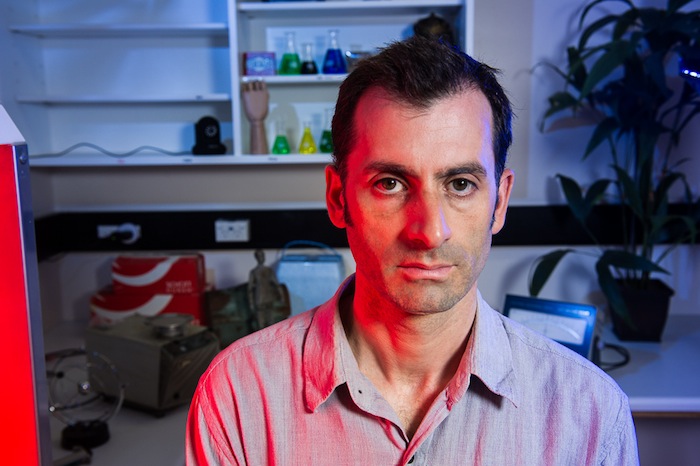 Boho Interactive has been creating interactive theatre since 2006, but the company's new show brings a whole new element into the picture. Word Play is a 'live cinema' experience, which means that the show is performed live in one location and streamed via high-speed video broadband to the audience, in a totally different location.This is not just an exercise in videoconferencing, however. Rather than a static shot of three performers in a room performing to a fixed camera, the show is more like a movie which is being performed, filmed, edited and screened in realtime. The actors will switch between performing and filming, and the vision will switch between a huge array of cameras as the performance moves through a series of disused CSIRO laboratories.Add to that the fact that the audience will be interacting live with the performers via mobile phone, asking questions, making decisions and in some instances directly controlling the performers in live video-game sequences, and the result is a genuine hybrid of film, theatre and video gaming.A 'live cinema' work demands a very different approach to making a work of theatre, and so Boho is excited to welcome filmmaker Marisa Martin on board as Word Play director. An experienced independent filmmaker and director, Marisa is the founder and director of the Lights! Canberra! Action! film festival and the head of EoR Media.
Boho Interactive has been creating interactive theatre since 2006, but the company's new show brings a whole new element into the picture. Word Play is a 'live cinema' experience, which means that the show is performed live in one location and streamed via high-speed video broadband to the audience, in a totally different location.This is not just an exercise in videoconferencing, however. Rather than a static shot of three performers in a room performing to a fixed camera, the show is more like a movie which is being performed, filmed, edited and screened in realtime. The actors will switch between performing and filming, and the vision will switch between a huge array of cameras as the performance moves through a series of disused CSIRO laboratories.Add to that the fact that the audience will be interacting live with the performers via mobile phone, asking questions, making decisions and in some instances directly controlling the performers in live video-game sequences, and the result is a genuine hybrid of film, theatre and video gaming.A 'live cinema' work demands a very different approach to making a work of theatre, and so Boho is excited to welcome filmmaker Marisa Martin on board as Word Play director. An experienced independent filmmaker and director, Marisa is the founder and director of the Lights! Canberra! Action! film festival and the head of EoR Media.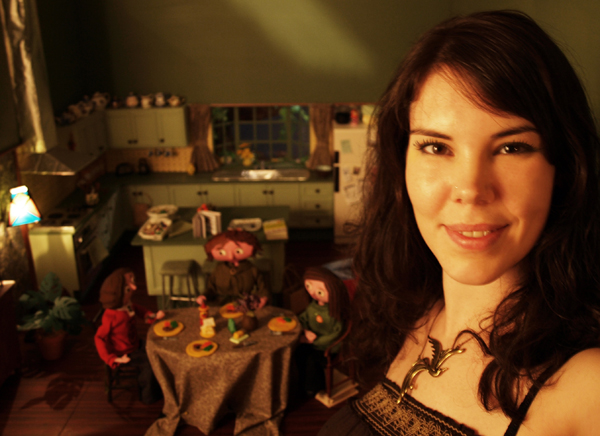 I asked Marisa a few questions about her previous work, and about the challenges of creating a live interactive film experience.David: Word Play is the story of a disease that infects language and ideas, and the consequences of a widespread outbreak. I believe you've touched on similar themes in some of your previous work?Marisa: That's right - One If By Will was a short film I made in 2006 set in a post-apocalyptic society where people were afraid to communicate with one another. It asked the question 'What happens when people stop talking?' Within that world it was the story of a couple, and how quickly relationships erode, dissolve and disintegrate when communication breaks down.David: What are the biggest differences in creating a work on screen versus live on a stage?Marisa: One difference is that in theatre there's a much stronger focus on actors, whereas in film I find the focus is much more on the production team. In theatre it comes down to the actors on stage to make it work - they can't just say 'can we do that again?' In film there's a greater focus on the camera and the design. With Word Play, both of those elements are critical and pretty inseparable.One thing that film can do that theatre can't is to invite the audience to focus on particular things, because we can use the camera to direct what the audience sees. In the theatre it's always a wide shot. With Word Play I'm going to mix up the vision - we'll use wide shots, mid-shots, close-ups, point-of-view shots.It also means that we'll be able to play on nuance much more - when the performer's face is as big as the screen, you can do more with less.David: How will the performers respond to the questions, decisions and instructions made by the audience?Marisa: A lot of that will be filtered through me so that's something different to film and TV again because I will be in their ear. I can tell them to tone it down, to move their head because the camera's not in the right spot. It's going to be a different challenge for them. And the second half of the play is going to be nuts - the show becomes a survival horror game.For me it will be like live TV. For them it will be like a mixture of theatre and film-making. For the audience it will be the most unusual experience ever. It will be the unique.Where: CSIRO Discovery Centre, Clunies Ross street, ActonWhen: 7:30pm Wednesday – Saturday 15-18 May, 22-25 May, 29 May-1 JuneTickets: $20 – buy tickets here.Top image by Rohan Thomson.This is a Centenary of Canberra project, proudly supported by the ACT Government & CSIRO.
I asked Marisa a few questions about her previous work, and about the challenges of creating a live interactive film experience.David: Word Play is the story of a disease that infects language and ideas, and the consequences of a widespread outbreak. I believe you've touched on similar themes in some of your previous work?Marisa: That's right - One If By Will was a short film I made in 2006 set in a post-apocalyptic society where people were afraid to communicate with one another. It asked the question 'What happens when people stop talking?' Within that world it was the story of a couple, and how quickly relationships erode, dissolve and disintegrate when communication breaks down.David: What are the biggest differences in creating a work on screen versus live on a stage?Marisa: One difference is that in theatre there's a much stronger focus on actors, whereas in film I find the focus is much more on the production team. In theatre it comes down to the actors on stage to make it work - they can't just say 'can we do that again?' In film there's a greater focus on the camera and the design. With Word Play, both of those elements are critical and pretty inseparable.One thing that film can do that theatre can't is to invite the audience to focus on particular things, because we can use the camera to direct what the audience sees. In the theatre it's always a wide shot. With Word Play I'm going to mix up the vision - we'll use wide shots, mid-shots, close-ups, point-of-view shots.It also means that we'll be able to play on nuance much more - when the performer's face is as big as the screen, you can do more with less.David: How will the performers respond to the questions, decisions and instructions made by the audience?Marisa: A lot of that will be filtered through me so that's something different to film and TV again because I will be in their ear. I can tell them to tone it down, to move their head because the camera's not in the right spot. It's going to be a different challenge for them. And the second half of the play is going to be nuts - the show becomes a survival horror game.For me it will be like live TV. For them it will be like a mixture of theatre and film-making. For the audience it will be the most unusual experience ever. It will be the unique.Where: CSIRO Discovery Centre, Clunies Ross street, ActonWhen: 7:30pm Wednesday – Saturday 15-18 May, 22-25 May, 29 May-1 JuneTickets: $20 – buy tickets here.Top image by Rohan Thomson.This is a Centenary of Canberra project, proudly supported by the ACT Government & CSIRO.

Word Play
 Something is wrong.In the last few months, a new disease has emerged that is transmitted not by water, by air, by contact – but by speech. Language. Via text messaging and email, telephone or video.This disease attacks thought itself, undermining our ability to think critically and resist other people's influence. This is an epidemic of harmful ideas and broken logic. And it’s spreading. Whole communities of people, highly contagious, wandering about, unable to talk, unable to take care of themselves, looking for things to believe in.In a few short months, the epidemic has hit a critical mass and gone global. The population of entire countries have been infected and gone under, and all international communications have collapsed entirely. In Australia, the last remaining survivors have been quarantined in bunkers, isolated from any potentially infected communications from the world outside.Now, as food and medical supplies are running short, a group of scientists from a medical research laboratory are about to embark on a last-ditch attempt to release a cure. Boho invites you join us as we open channels to the last functioning research centre in Australia for a lecture that will turn the tide of this epidemic.Don’t believe everything you hear.
Something is wrong.In the last few months, a new disease has emerged that is transmitted not by water, by air, by contact – but by speech. Language. Via text messaging and email, telephone or video.This disease attacks thought itself, undermining our ability to think critically and resist other people's influence. This is an epidemic of harmful ideas and broken logic. And it’s spreading. Whole communities of people, highly contagious, wandering about, unable to talk, unable to take care of themselves, looking for things to believe in.In a few short months, the epidemic has hit a critical mass and gone global. The population of entire countries have been infected and gone under, and all international communications have collapsed entirely. In Australia, the last remaining survivors have been quarantined in bunkers, isolated from any potentially infected communications from the world outside.Now, as food and medical supplies are running short, a group of scientists from a medical research laboratory are about to embark on a last-ditch attempt to release a cure. Boho invites you join us as we open channels to the last functioning research centre in Australia for a lecture that will turn the tide of this epidemic.Don’t believe everything you hear.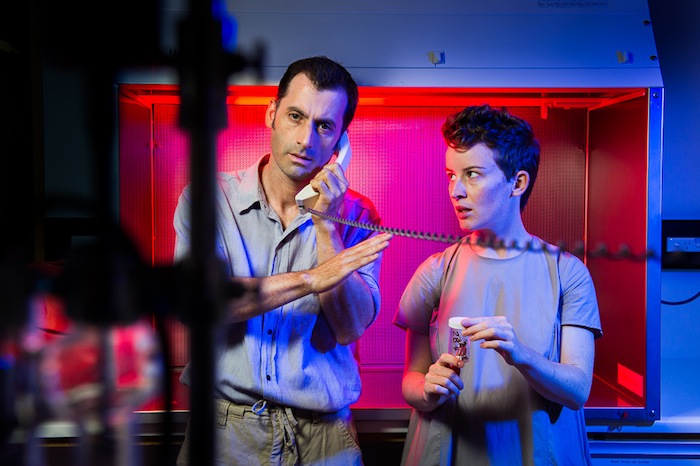 Boho's new show Word Play is performed on-screen from across the city. The audience are situated in the CSIRO Discovery Centre lecture theatre, while the performers are live-streamed from a laboratory across the city using a high-speed video broadband connection.Using text messages and a purpose-built phone app, the audience are able to interact directly with the performance, communicating with the performers and controlling them through a series of live computer game sequences.Word Play is a performance lecture exploring concepts from epidemiology, a live cinema experience and a hands-on video game in the survival horror genre.Bring your phone.
Boho's new show Word Play is performed on-screen from across the city. The audience are situated in the CSIRO Discovery Centre lecture theatre, while the performers are live-streamed from a laboratory across the city using a high-speed video broadband connection.Using text messages and a purpose-built phone app, the audience are able to interact directly with the performance, communicating with the performers and controlling them through a series of live computer game sequences.Word Play is a performance lecture exploring concepts from epidemiology, a live cinema experience and a hands-on video game in the survival horror genre.Bring your phone. Since forming in 2006, Boho's Michael Bailey, Jack Lloyd and David Finnigan have presented interactive cross-artform performances to festivals, theatres, science conferences and schools including the Brisbane Under The Radar Festival, the Asia-Pacific Complex Systems Conference, the Adelaide Fringe Festival, the Manning Clark House Centre for Scholarly & Cultural Research, TEDxCanberra, CSIRO’s Lecture series and the Street Theatre’s Independent Season.Boho's recent works include True Logic of the Future (2010), a science fiction 'parable for the Anthropocene' exploring the challenges facing Australia in the 21st century from the forces of climate and global change, and Food for the Great Hungers (2009), an interactive re-imagining of Australian history since 1901.Word Play combines Boho's unique style of interactive theatre with the world of film. For this project, Boho have welcomed on board director Marisa Martin, a film-maker and head of the Lights! Canberra! Action! film festival. Marisa says of the play, ' a filmmaker, the use of cameras in the production really appeals to me and throwing in interactivity makes for an exciting storytelling environment I've not been able to explore before. It should make for a highly engaging experience for the audience.'Word Play features performers Raoul Craemer, Cathy Petocz and Euan Bowen.
Since forming in 2006, Boho's Michael Bailey, Jack Lloyd and David Finnigan have presented interactive cross-artform performances to festivals, theatres, science conferences and schools including the Brisbane Under The Radar Festival, the Asia-Pacific Complex Systems Conference, the Adelaide Fringe Festival, the Manning Clark House Centre for Scholarly & Cultural Research, TEDxCanberra, CSIRO’s Lecture series and the Street Theatre’s Independent Season.Boho's recent works include True Logic of the Future (2010), a science fiction 'parable for the Anthropocene' exploring the challenges facing Australia in the 21st century from the forces of climate and global change, and Food for the Great Hungers (2009), an interactive re-imagining of Australian history since 1901.Word Play combines Boho's unique style of interactive theatre with the world of film. For this project, Boho have welcomed on board director Marisa Martin, a film-maker and head of the Lights! Canberra! Action! film festival. Marisa says of the play, ' a filmmaker, the use of cameras in the production really appeals to me and throwing in interactivity makes for an exciting storytelling environment I've not been able to explore before. It should make for a highly engaging experience for the audience.'Word Play features performers Raoul Craemer, Cathy Petocz and Euan Bowen. Created in residence at the CSIRO, Boho's new work looks at the behaviour of epidemics, focusing on an ominous trend in medical research over recent decades.As a result of widespread use of antibiotics, almost every type of harmful bacteria has become stronger and less responsive to treatment. Antibiotics that were once reserved as drugs of last resort are now routinely deployed, and the microbes are now overcoming even these final defences.Old scourges such as Tuberculosis are returning, completely immune to remedy. Meanwhile, new and appallingly lethal diseases such as Hendra, SARS and Ebola are increasingly brought into contact with people through evolving networks of human behaviour – urbanisation, agriculture and travel. The results are impossible to predict.Boho's research into this area included a visit to the Australian Animal Health Laboratories near Geelong, Victoria, where we were lucky enough to be taken to Biosecurity Level 3, and visit the room where the samples of Ebola, Hendra, Nipah and SARS were kept. Read more here.
Created in residence at the CSIRO, Boho's new work looks at the behaviour of epidemics, focusing on an ominous trend in medical research over recent decades.As a result of widespread use of antibiotics, almost every type of harmful bacteria has become stronger and less responsive to treatment. Antibiotics that were once reserved as drugs of last resort are now routinely deployed, and the microbes are now overcoming even these final defences.Old scourges such as Tuberculosis are returning, completely immune to remedy. Meanwhile, new and appallingly lethal diseases such as Hendra, SARS and Ebola are increasingly brought into contact with people through evolving networks of human behaviour – urbanisation, agriculture and travel. The results are impossible to predict.Boho's research into this area included a visit to the Australian Animal Health Laboratories near Geelong, Victoria, where we were lucky enough to be taken to Biosecurity Level 3, and visit the room where the samples of Ebola, Hendra, Nipah and SARS were kept. Read more here.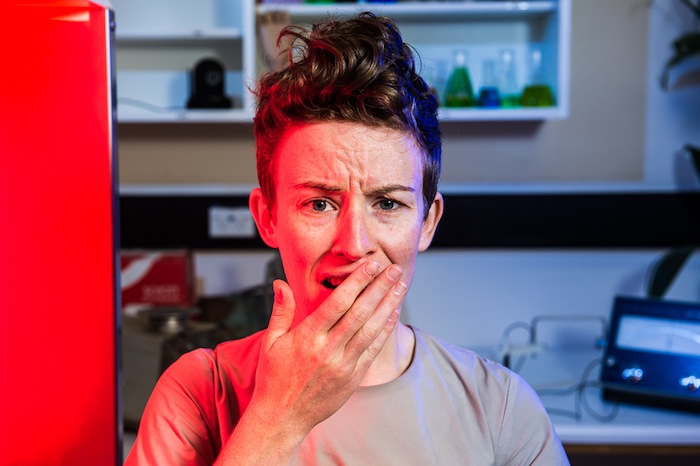 Where: CSIRO Discovery Centre, Clunies Ross street, ActonWhen: 7:30pm Wednesday - Saturday 15-18 May, 22-25 May, 29 May-1 JuneTickets: $20 - buy tickets here.Images by Rohan Thomson.This is a Centenary of Canberra project, proudly supported by the ACT Government & CSIRO.
Where: CSIRO Discovery Centre, Clunies Ross street, ActonWhen: 7:30pm Wednesday - Saturday 15-18 May, 22-25 May, 29 May-1 JuneTickets: $20 - buy tickets here.Images by Rohan Thomson.This is a Centenary of Canberra project, proudly supported by the ACT Government & CSIRO.

